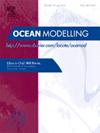High-frequency detachment of low salinity water from the Changjiang River plume
IF 2.9
3区 地球科学
Q2 METEOROLOGY & ATMOSPHERIC SCIENCES
引用次数: 0
Abstract
Under the influence of winds, tides, and river runoff, parts of the Changjiang River plume (CRP) can detach from the main body to form isolated low salinity water (LSW) lens, which continue to expand and play a crucial role in influencing the biogeochemical processes in the far-field region of the estuary. Using SMAP satellite sea surface salinity (SSS) observations from 2016 to 2019, this study is the first to identify the high-frequency detachment of LSW (HFDLSW) originating from the CRP, multiple LSWs can detach sequentially from the main body of CRP within 2–3 days. The physical mechanisms behind this phenomenon were explored using the Semi-implicit Cross-scale Hydroscience Integrated System Model (SCHISM), based on an unstructured grid. Wind field analysis reveals that all events of the HFDLSW of LSW occurred during a process where southerly winds gradually intensified and were followed by a period of relaxation. Based on this pattern, a series of numerical sensitivity experiments were conducted to clarify the role of relaxed winds in the HFDLSW. The results indicate that temporal variations in the wind field directly regulate the vertical and horizontal currents in the upwelling region outside the Changjiang River Estuary, dominating the HFDLSW process, with the upwelling reaching its peak intensity before wind relaxation occurs. The resulting upward transport of high salinity water divides the CRP into two parts by the upwelling center, forming the first isolated LSW lens. Subsequently, as the wind field relaxes and the upwelling intensity weakens, the upwelling is still able to detach a small portion of the outer waters within the CRP, forming the second isolated LSW lens. Under the accompanied weak mixing conditions, this second LSW lens can persist and continue to expand outward. Furthermore, horizontal flow deflection towards the main body of the CRP further increases the distance between the first and second isolated LSW lenses, completing the process of HFDLSW.
长江羽流中低盐度水的高频分离
在风、潮、径流的作用下,长江羽流(CRP)的一部分可以从主体中分离出来,形成孤立的低盐度水透镜体,并不断扩大,对河口远场区生物地球化学过程起着至关重要的影响。利用2016 - 2019年SMAP卫星海面盐度(SSS)观测数据,首次发现了源自CRP的LSW高频脱离(HFDLSW),多个LSW可在2-3天内顺序脱离CRP主体。使用基于非结构化网格的半隐式跨尺度水文科学集成系统模型(SCHISM)探索了这一现象背后的物理机制。风场分析表明,东南偏南大风的所有事件都发生在南风逐渐增强和减弱的过程中。在此基础上,进行了一系列数值敏感性实验,以阐明松弛风在高强度强降水中所起的作用。结果表明:风场的时间变化直接调节了长江口外上升流区域的垂直和水平气流,主导了HFDLSW过程,上升流在风松弛之前达到峰值强度。由此产生的高盐度水向上输送通过上升流中心将CRP分成两部分,形成第一个孤立的LSW透镜。随后,随着风场的松弛和上升流强度的减弱,上升流仍然能够将CRP内部的一小部分外部水体分离,形成第二个孤立的LSW透镜。在伴随的弱混合条件下,第二个LSW透镜可以持续存在并继续向外扩展。此外,流向CRP主体的水平流偏转进一步增加了第一和第二分离LSW透镜之间的距离,完成了HFDLSW的过程。
本文章由计算机程序翻译,如有差异,请以英文原文为准。
求助全文
约1分钟内获得全文
求助全文
来源期刊

Ocean Modelling
地学-海洋学
CiteScore
5.50
自引率
9.40%
发文量
86
审稿时长
19.6 weeks
期刊介绍:
The main objective of Ocean Modelling is to provide rapid communication between those interested in ocean modelling, whether through direct observation, or through analytical, numerical or laboratory models, and including interactions between physical and biogeochemical or biological phenomena. Because of the intimate links between ocean and atmosphere, involvement of scientists interested in influences of either medium on the other is welcome. The journal has a wide scope and includes ocean-atmosphere interaction in various forms as well as pure ocean results. In addition to primary peer-reviewed papers, the journal provides review papers, preliminary communications, and discussions.
 求助内容:
求助内容: 应助结果提醒方式:
应助结果提醒方式:


